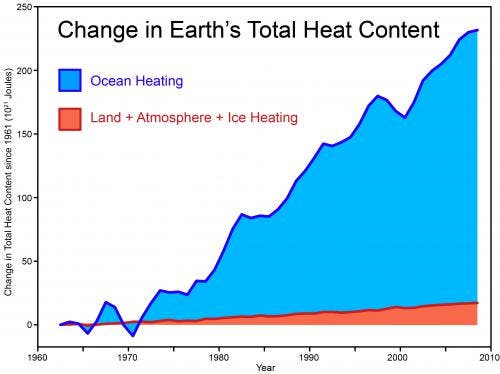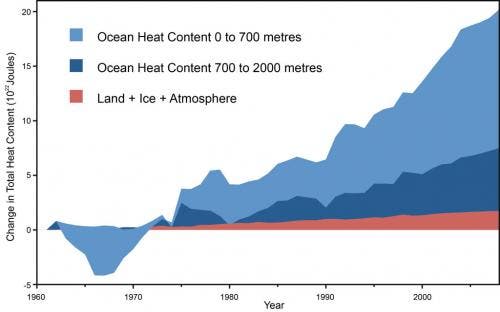After they studied how much man-made heat got sucked by the world’s oceans in the past 150 years, researchers found the heat content doubled since 1997. In other words, the oceans absorbed just as much heat in the past 20 years or so as they did in the prior 130 years. There’s more bad news. The rate at which oceans soaked the heat rose sharply since the 2000s and hasn’t faltered since. This can only mean a re-doubling that comes with unforeseeable consequences in the coming decades.

The oceans are our carbon and heat sinks. These absorb up 30-50% of the CO2 produced through burning fossil fuels and 90% of the heat. The first produces acidification, while the other warms the waters. They both keep, however, the surface from getting warmer. Even we didn’t have the oceans to soak up all this extra energy and carbon, then global surface temperatures would have been much, much higher than today. Unfortunately, we might one day get to find out if we’re continue on a business as usual route. Just like sponge, there’s a limit to how much carbon or energy the oceans can soak.

The researchers analyzed more than 150 years of ocean temperature readings and other data, from the British research ship Challenger in the 1870s to today’s high-tech underwater monitors and climate models. The team estimates some 150 zettajoules of energy were absorbed by the ocean’s waters from 1865 to 1997. Since 1997, another 150 were absorbed, according to the paper published in Nature Climate Change.
To put this into perspective, the energy absorbed in the past 18 years is equivalent to having a Hiroshima-style bomb being exploded every second for 75 straight years.
“The changes we’re talking about, they are really, really big numbers,” said study co-author Paul Durack, an oceanographer at the Lawrence Livermore National Lab in California. “They are nonhuman numbers.”
About 35 percent of the heat taken in by the oceans during the industrial era now resides at a depth of more than 700 meters, and more and more of that heat tends to go to deeper layers.

“These finding have potentially serious consequences for life in the oceans as well as for patterns of ocean circulation, storm tracks and storm intensity,” said Oregon State University marine sciences professor Jane Lubchenco, the former chief of the National Oceanic and Atmospheric Administration.
Managing heat and carbon isn’t impossible though. Last December, world leaders agreed to keep global warming to a 1.5 degrees Celsius warming threshold past levels recorded in the industrial age. We need all stakeholders involved to reach this goal set at COP21, in Paris: governments, companies, citizens.


